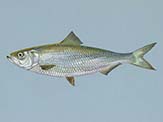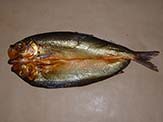Meats and Sausages
Herring
Fish RecipesHerring, Atlantic (Clupea harengus), Protein-17.96%, Fat-9.04%, Water-72.05%
Herring, Pacific (Clupea pallasii), Protein-16.39%, Fat-13.88%, Water-71.52%
The most abundant and commercially important species belong to the genus Clupea, found particularly in shallow, temperate waters of the North Pacific (Clupea pallasii) and the North Atlantic oceans, including the Baltic Sea (Clupea harengus), as well as off the west coast of South America (Chile).
The average size of herring is between 9-12” (23-30 cm). The body is covered with large, thin, loosely attached scales. Unlike most white fish, the chemical composition of herring varies considerably with the season and the breeding cycle; the fat content of herring may be less than 1 per cent immediately after spawning, and more than 20 per cent as spawning time approaches again. Herring is one of the most popular fish in northern European countries. It is produced in oil, sour cream, sour cream and beets, it is smoked, and canned in many different ways.
- Kipers - the kipper and the kipper fillet are the most important smoked products made from herring in Britain.
- Bloaters - are whole ungutted herring, dry salted for about 6 hours and cold smoked for 8-12 hours in a traditional chimney kiln or 4 hours in a mechanical kiln; the fish are dried without smoke for most of the time in the kiln, and smoke is applied only during the last hour or so, so that the fish retain their bright silver appearance.
- Buckling - are hot smoked herring; the flesh is cooked during the smoking process. In British practice the herring are nobbed, that is the head and long gut are removed, brined, and smoked for about 3 hours in a mechanical kiln, the temperature being raised gradually from about 86° F, 30°C at the start to 167° F, 75°C during the last hour.
- Red herring - are whole ungutted herring that have been heavily salted and then cold smoked for 2-3 weeks; the hard cured product is exported, mainly to Mediterranean countries.
Kipers
A kipper is a fat herring with guts and gills removed, split down the back from head to tail, lightly brined, dyed if desired, and cold smoked. All herring, whether chilled or thawed after cold storage, should first be washed to remove loose scales and other debris. The herring is laid on the filleting bench with the back of the fish facing the operator. The blade of a small kippering knife is inserted at the centre of the back of the head and a cut made through the skull to the mouth. The knife is again inserted at the same entry point and a second deep cut is made down to the tail, keeping the blade of the knife close enough to the backbone to leave just a thin layer of flesh over it. The herring is then opened so that the backbone is on the left side of the kipper, gills and guts are removed, and the backbone trimmed where necessary with the knife. The split herring is then washed before brining. The brining time for kippers depends mainly upon the size of the fish and the fat content; the salt content of the finished product should be between 1-8 and 2-5 percent to suit the average palate.
Kipers, time in 80° brine:
- Small winter herring-10 minutes
- Medium-size fat herring-15 minutes
- Large herring-20 minutes
- Very large herring-30 minutes
Add 2.2 lbs of salt to 1 gallon of water. This makes 80 degrees brine.
Kipers were smoked in mechanical kiln for 4 hours. In home smokers smoke for 6 hours at 86° F (30°C) or lower. The estimated weight loss is about 14%.
Making Kipper Fillets
Kipper fillets are prepared either by cutting block fillets, smoking them and then cutting single fillets from them, or by cutting single fillets from the raw herring and smoking them. Block fillets are taken by making a transverse cut across the back of the head of the herring, and then cutting down towards the belly wall and in towards the backbone, continuing the cut to the tail so that the flesh on one side of the fish is separated from the bone. Care must be taken not to penetrate the belly wall. The cut is repeated on the other side of the fish, so that the double fillet, joined by the skin and back fins, can be removed from the head and skeleton in one piece. The tail fin is left on if the block fillets are to be tentered.
- Kipper fillets, time in 80° brine:
- Medium-size 3-4 minutes
- Large fillets 6-8 minutes
Kipper fillets are smoked for 2½-3 hours in a mechanical kiln, depending on size, and should lose 10-12 per cent of their brined weight. The temperature in the kiln should not rise above 85° F, 30° C. Kipper fillets may take 4-8 hours in a traditional smokehouses.
Bloaters
Bloaters are made from whole, ungutted and slightly salted herring. They owe their characteristic flavor, to the enzymes or ferments from the gut. The fish are salted and left overnight. After salting the fish are washed and threaded on speats through the gills and mouth or through the eyes. The fish are processed as follows:
Drying (no smoke or very thin smoke) at 185 - 194° F (85 - 90° C) for 3 hours.
Smoking at 185 - 194° F (85 - 90° C) for 1 hour.
As a result, the fish develops little color and and a faint smoky flavor.
Buckling (Herring)
Buckling, originally a German product, very popular on the continent is a hot smoked herring. There is not a standard form of fish preparation. The fish can be beheaded or not, also, the gut may or may not be removed.
- In Britain, nobbing the herring was the preferred method - the whole herring is beheaded and the gut pulled out, leaving any roe or milt in position.
- The fish are cured in 80° brine for 60 minutes, briefly rinsed and hung on speats. The speat is pushed through the thick part of the flesh near the shoulder. The fish are drained and let to dry until they don’t drip water anymore.
- Herring are placed in smokehouse (it is customary to smoke them when still wet to obtain a golden brown color) and they are:
- smoked at 80-90° F (27-32° C) for 1 hour. This dries out the skin and will help to obtain golden brown color.
- smoked at 110 - 120° F (43 - 49° C) for 1 hour.
- cooked with smoke at 160 - 170° F (72 - 77° C) for 1 hour.
Red Herring
Red herring was a popular product in England and Netherlands as it had en excellent keeping properties. The fish was well mixed with salt, taking about 30% salt to 100% of the fish (by weight). The fish was not gutted. Then the fish were placed in barrels and cured for 3 days to even 6 weeks. Then the fish were desalted in water, drained and dried from 12 to 24 hours. After that the fish were smoked from 3 to 6 weeks at about 65° F (18° C). The finished product had a very long shelf life and was exported to counties with warmer climate.















